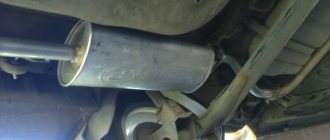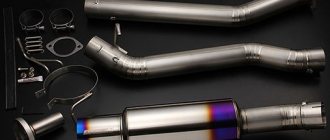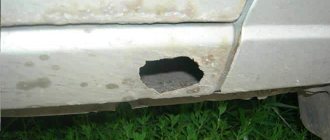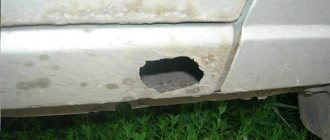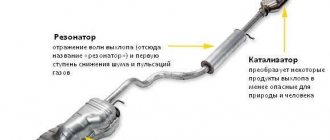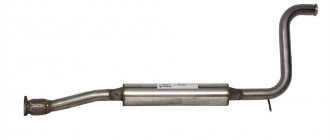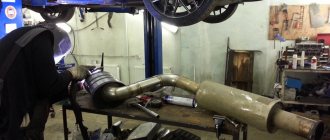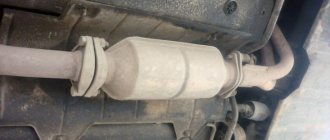DIY muffler repair without welding
In such a development of events, of course, it is necessary to repair the car, but this does not mean at all that you will have to print out an emergency supply of money that has been accumulated for a long time or take out a ruinous bank loan.
It is enough to spend a little time and effort - and the through hole can be eliminated with little means and with your own hands, and without the use of a welding machine.
After a well-carried out repair in a personal garage, the muffler will faithfully work for many more years, and with purely summer use of the car - up to five years.
What is bandage tape for?
Repairing a muffler with bandage tape is a temporary, therapeutic measure that does not replace a full repair or replacement. Using high-temperature tape (also called scotch tape) can help an exhaust system that has worn out over time. Often the muffler, resonator, and pipes—connecting and exhaust—fail. These parts are made of thin steel, which is susceptible to corrosion, which causes holes, cracks, and breaks to appear.
Many car owners are not ready to invest large sums in a full repair of the exhaust system, so they use bandage tape. This is an excellent alternative to welding.
Recommendations from the master
Not so long ago, the happy owners of Zhiguli and Moskvich cars, who today seem to be true Kulibins, knew and used a wide range of quite effective methods for restoring the performance of the muffler.
Due to the fact that in those days it was almost impossible to get its new analogue due to the shortage and considerable cost, Soviet car enthusiasts used the following methods:
- Installation of various types of iron hoops;
- Filling with cement and clay fillings that are resistant to strong heat;
- Wrapping with fiberglass;
- Preventive making of grooves to remove condensate;
- Coating the muffler with moisture-repellent chemical compounds created somewhere in closed military-industrial complex laboratories.
If water drips from the muffler
The condensate formed in the muffler is ordinary water that appears during the transition from a gaseous to a liquid state. This sounds quite harmless if this moisture did not have a detrimental effect not only on the exhaust pipe itself, but also on the internal systems of the car.
If we talk about why water drips from the exhaust pipe, then it is worth highlighting several reasons:
- Active use of the vehicle, especially in the cold season, when the engine is very hot and the air temperature is low.
- Car with auto start function. In this case, the pipe will heat up in approximately 20 minutes. At this time, the frozen condensate melts, but does not evaporate completely. Due to this, under the influence of a strong flow of exhaust gases, the liquid splashes out of the muffler.
Is it worth repairing the muffler yourself?
Currently, car mufflers and the components necessary for their operation can be purchased without even leaving home. There is no longer any shortage of such spare parts on the market, but they are still not cheap at all.
Heat-resistant filler
Pros and cons of the CVT on the Mitsubishi Outlander
The heat-resistant filler is a heat-resistant ceramic fiber made in Finland. The thermal stability temperature of this material is about 1200C° without loss of its physical properties. We use this type of ceramic fiber in the production of our own flame arresters; it can be used for stuffing mufflers and resonators, for flame arresters that you make yourself.
The ceramic filler is non-toxic, does not harm the environment, does not oxidize under the influence of aggressive environments (sulfur, fuel combustion products), does not react with water and does not absorb moisture and does not rot. The product is presented in the assortment of the plamik.ru store with 1 kg packaging in an individual bag, which is very convenient for the buyer. When working with this type of filler, no special protective equipment is required, since it does not contain harmful substances or glass, as is the case with fiberglass-based fillers. By purchasing our filler, you are guaranteed to receive a high-quality, safe product at a good price.
The practical application of this filler is quite wide and does not stop only with the car exhaust system; you can also use it in everyday life outside the city for thermal insulation of a generator, fireplace, etc. You can get advice and buy filler for a muffler on our website plamik.ru, through an online consultant on the store pages by phone or using the popular instant messengers whatsapp, viber:
+7
Wide selection of modern auto sealants
Naturally, any prudent and economical car enthusiast will not rush to spend his hard-earned savings on buying a new unit just because of a few almost invisible fistulas found on the “original” muffler.
To successfully and permanently seal defects in the exhaust pipe without resorting to a labor-intensive welding procedure, you no longer have to look for or invent some clever method.
It is enough to use advanced devices produced today specifically for such repairs. Modern auto sealants allow you to quickly and efficiently eliminate holes of any diameter and cracks of any length.
What is thermal tape for a muffler?
It came into use thanks to the construction industry. In it, and then in other industries, dense asbestos fabric with colossal heat-resistant characteristics was widely used. So, she was able to easily withstand temperatures up to 1500 degrees Celsius! This fabric became widespread, but then the process of its use began to noticeably slow down and fell to a minimum due to its obvious harmfulness to humans and their environment.
Currently, developed countries almost never use it for direct economic purposes. However, practice suddenly proved the new quality of such a heat-resistant material - it can make, in particular, an excellent thermal tape for the exhaust manifold.
However, it is produced in a different way, using different silicon compounds (for example, silica filaments), original LR technology and other modern know-how. Despite a fundamentally different technological approach to their production, they have the same excellent heat-resistant properties and reliability. Ordinary thermal tape, widely used today in the car industry, is a strip approximately 5 cm wide of a thick black color, similar to graphite.
Easy installation of iron patch
An example of an effective solution for such problems is DoneDeal DD6785 High Temperature Ceramic Steel Reinforced Sealant. It makes it possible to quickly install a metal plug on a worn muffler in the area of gas breakdown.
It makes sense to use this same tool to prevent possible defects during periodic inspection and maintenance of exhaust units. It will also be an excellent help when installing a new exhaust system instead of a worn one.
Why do you need to wrap?
Those skeptics who doubt the ability of such thermal tape to increase engine power by several horsepower should give several of the most common arguments regarding what other significant advantages thermal tape provides for the muffler, and why it may be needed:
- This thermal tape helps eliminate the ringing, sometimes rattling sound in the muffler during the exhaust, which is observed quite often in practice. “Cushioning” is similar to how if a rubber lining was placed at the bottom of a metal dish - now when you throw a nut there, sound will be absorbed;
- Thermal tape helps reduce the temperature under the engine hood, which helps extend the life of many parts, primarily those made of plastic, as well as the car battery;
- The main advantage of thermal tape is increased motor power. It can be simply explained using physical laws. The fact is that the exhaust system, by its structure, contributes to the braking of exhaust gases. Therefore, the faster they are retracted, the easier it is for the engine to work, so that it does not spend additional significant effort “pushing” them through the muffler pipe. Having served their purpose, the gases enter the cold pipe of the exhaust manifold, immediately cooling and compressing, thereby reducing their exit speed. Thermal tape on the muffler prevents them from cooling quickly, that is, it becomes a constant assistant to the engine. Due to the fact that he does not have to spend extra effort on running them, the efficiency of the motor power increases, and this is the main argument in favor of why thermal tape is needed.
Making a patch and drilling holes
To do this, a rectangular section is cut out of a piece of rolled steel about a millimeter thick. Its area should be approximately half the size of the segment covered by the burnout.
Holes are made along the edges of such a plug into which fasteners intended for fixing metal products will be screwed.
Nuances of installation work
For winding, it is better to use tape 4-5 cm wide. This will be easier to work with. Before starting the process, it is recommended to coat the collector with anti-corrosion paint, this will significantly extend its service life.
Next, follow the recommendations:
- Before winding, it is better to soak the tape in water for 1-2 hours. This will make it softer and more pliable.
- When winding, each subsequent layer should overlap the previous one by about half.
- After wrapping each section of the pipe, the thermal tape is fixed using metal clamps.
- At the very end, fold the tape inward so that there are no protruding edges.
The thicker the layer of winding material, the better the insulation, but do not forget that the thickness of the pipe also increases. Sometimes difficulties arise due to tight gaps. Therefore, before finally fixing the thermal tape with clamps, we advise you to install the manifold on the engine and make sure that all components match.
DIY winding
This work can be done on your own without the help of professional auto mechanics, but you are unlikely to be able to do it without an assistant. Difficulties can be caused by winding at joints and bends. Branching pipes cause even more difficulties, because here it is no longer possible to make the winding with one piece of tape.
Sealing the muffler with an iron patch
The distance between the holes is about 2.5 centimeters. Next, the plug with a layer of autosealant is screwed with a cordless screwdriver or drill onto the damaged area of the muffler, previously cleaned with an iron brush.
Heat-resistant substances in the sealant composition
Automotive muffler sealant contains heat-resistant additives that can withstand temperatures up to almost one and a half thousand degrees.
Such additives are:
- Sodium silicate;
- Clay;
- Steel powder;
- Artificial fiber.
The period for 100% curing of ceramic sealant in normal weather is about a day. To speed up polymerization somewhat, you can start warming up the engine three hours after installation.
Design and types of muffler bands
In the simplest case, the bandage is a strong elastic tape, on one side of which an adhesive layer is applied. Typically, the length of the tape is 100-102 cm, width - 5 cm. Today on the market there are bandages made of various materials and different adhesive compositions.
The most popular bandages are those with a base made of two materials:
- Fiberglass (fiberglass) is an elastic, high-strength tape that is resistant to heating up to temperatures of about 420°C;
- Reinforced ceramic tape - a bandage with sufficient elasticity can withstand temperatures up to 650°C or more;
- Aluminum - Thin aluminum tape is highly durable and can operate at temperatures up to 1000°C.
Compositions based on two groups of compounds can be used as an adhesive base:
- Thermosetting resins, primarily epoxy;
- Silicates, most often sodium silicate (more precisely, sodium metasilicate, better known as “liquid glass”).
The adhesive composition hardens when heated against a muffler or pipe, acquires very high strength, ensures tightness and can withstand thermal loads for a long time. Also, both groups of adhesives are acid-resistant, which increases the reliability of the bandage.
In general, today manufacturers offer bandages of the same types with similar characteristics, so the market cannot boast of much variety and choice.
Using ceramic sealant when replacing a muffler
Do not abandon the ceramic sealant and, if necessary, install a new exhaust system. As is known, the joints of pipe flanges and seals do not always guarantee one hundred percent impermeability to exhaust gases.
The reason for this is usually insufficiently high-quality manufacturing of components and assemblies supplied to the market for auto parts.
How to repair a muffler using bandage tape
Let's move on to how to properly use tape to repair a muffler.
- Step 1 . Prepare the muffler for use. It must be at room temperature - it is unacceptable to work with hot parts! Using a wire brush or other abrasive device, remove dirt, paint residues and burns. Degrease the surface.
- Step 2 . Prepare the bandage tape for use. If it is made on a silicate basis, open the package and pour water inside. Wait a few minutes, shaking the contents occasionally.
- Step 3 . Apply the bandage to the problem area . Wrap it tightly, as if you were looking at a regular elastic bandage. Additionally, secure with the wire that comes with the kit or another wire that you have on hand. Apply the tape overlapping, layer by layer. Start winding not from the damaged area, but with a margin of 1-2 cm. For high-quality repairs, eight to ten layers of tape are enough.
- Step 4 . Wait for the adhesive layer to harden - this will take a maximum of 45 minutes. Constantly level the tape all this time - this way the result will be much better. It takes one day for complete polymerization.
If you are using a sodium silicate bandage and only one part needs to be repaired, use the package at a time - it does not last long. Work in a warm (temperature 14–22 °C) well-ventilated area, use gloves as personal protective equipment.
Some manufacturers sell the tape complete with pastes and resins. They help speed up the hardening of the adhesive layer and improve sealing performance.
Follow the listed steps and our recommendations exactly - this will help you end up with a repaired muffler or other product that needs urgent restoration. But remember that this type of “reanimation” does not eliminate the need to replace the muffler in the future.
Muffler repair
The best way to avoid problems with restoring exhaust system parts is to seek help from specialists. The service center will advise you, make an appointment for diagnostics and carry out repairs of any complexity. Make an appointment with us by phone listed on the website, and we will serve you daily from 10:00 to 23:00. We provide services in St. Petersburg and the region. We guarantee prompt and high-quality execution of work. We have affordable prices and our own database of car parts from trusted suppliers.
Sealing a new exhaust system
This is why a completely new muffler can unpleasantly surprise a car enthusiast with smoke coming out of the joints and a suspicious whistling sound.
These annoying phenomena will be observed until the cracks are completely clogged with solid products of fuel combustion.
- If, when installing the muffler, you are not lazy and seal the joints with the specified composition, then such a development of events will be prevented in the bud.
- The entire exhaust line will be tightly sealed, so the car will not be frightened by smoke coming from under the bottom and a terrible whistle.
Features and characteristics of bandage tapes
The muffler repair tape is a wide elastic strip impregnated with an adhesive composition. It is applied to damaged areas: where there are holes and cracks. It works on the principle of a bandage: thanks to its elasticity, it not only covers damage, but also maintains the integrity of the exhaust system.
Three main tasks that bandage tape solves:
- closes voids in places of holes and cracks;
- strengthens elements damaged by corrosion;
- prevents breakdowns in the future (prevention).
The properties of the tape allow it to be used in other situations. It attaches well to different surfaces - aluminum, ceramic, steel, any types of polymers and fiberglass. If you have any unused scraps left, use them for minor household repairs.
Design
The length of the tape is one meter, although this parameter may vary less or more from different manufacturers. The standard width is 5 cm. Before purchasing, carefully study the packaging to understand whether the product is suitable for your purposes.
Manufacturing materials
On one side, an adhesive layer is applied to the surface of the tape, which ensures good adhesion to different surfaces. The materials of the base and adhesive layer also vary depending on the brand, but the most popular categories can be distinguished.
- Fiberglass (fiberglass) is a material with a high safety margin that can withstand temperatures up to 420 °C;
- Ceramics is a thin, high-strength material with additional reinforcement that can withstand temperatures up to 650 °C.
- Aluminum is a durable, elastic material that can easily withstand temperatures up to 1000 °C.
What about the adhesive base? There are two options here:
- epoxy or other thermosetting resin;
- sodium silicate or other silicates (for example, liquid glass).
While the tape is in the package, the adhesive coating on it is in a viscous state. When the product is applied to the surface to be protected, the glue hardens after some time and gains strength. The bandage is not only reliable, but also airtight and copes well with mechanical, chemical and thermal loads.
Possible configurations
On sale you can find tapes with an adhesive layer in various configurations:
- one product in individual packaging;
- one product complete with gloves;
- several products plus patches of different shapes (round, square, rectangular).
Some manufacturers supplement the package with wire for more reliable fixation. It is necessary to secure the bandage to the muffler or other element of the exhaust system until the adhesive composition completely “sets.” Afterwards the wire can be removed.
Please note: the packaging for the bandage tape must be sealed! Tears and punctures are unacceptable - this is a sign that you have received a low-quality product that will not perform its stated functions.
Can be sealed in any garage
Ceramic sealant for restoring a car muffler is easy to use in any garage workshop if there are conditions for
- Complete cleaning of dirt and rust from the area where the patch will be fixed;
- Cutting out the plug yourself with special scissors, a hand hacksaw or a grinder;
- Precise drilling of mounting holes;
- Tight fixation of screws for metal.
Product forms and sets of bandages
Today, muffler bands are presented in various sets and product forms:
- Single bandage tapes in individual packaging;
- Bandage tapes complete with gloves for ease of work;
- Extended kits include patches (round or square), bandage tape and wire for fixation.
Single tapes also often come with a wire, with which the bandage is fixed to the pipe until the resin has completely polymerized or the “liquid glass” has cured.
Since both types of adhesive should not be exposed to air or water prior to use, the muffler band must be supplied in a sealed package with a tight-fitting lid.
Sealing the muffler away from the workshop
However, it is not always possible to repair a muffler in a workshop where all the necessary tools are available. If fistulas and cracks make themselves felt on the road, then it will be almost impossible to carry out such repairs.
To do this, you will have to constantly carry a whole car service arsenal with you.
- Far from your home garage cooperative, you can repair the muffler using a special repair tape.
- It is a heat-resistant bandage for mufflers and is produced by the same brand as the ceramic sealant.
- This insulating tape is designed to instantly eliminate burnouts on mufflers and other gas lines heated to high temperatures.
Purpose of the muffler band
A car's exhaust system operates in harsh conditions, its components experience severe thermal loads and are exposed to an aggressive environment - hot gases with high chemical activity. Therefore, over time, the muffler, resonator, connecting and exhaust pipes, made of relatively thin steel, quickly corrode and lose mechanical strength. The result is the appearance of holes, cracks, or even large breaks that require repair or complete replacement of exhaust system parts.
Usually, a complete replacement of parts is associated with large financial costs, so car owners often resort to repairs. The problem can be solved by welding, but, as practice shows, it often only aggravates the situation. Therefore, today special repair kits - muffler bands - are becoming increasingly popular.
The muffler band is an elastic wide tape with an adhesive composition, which is used to seal holes, cracks and other damage to parts of the exhaust system of a car. The bandage, as the name suggests, wraps tightly around the muffler or pipe and covers the damage.
Muffler band LIQUI MOLY
Muffler band 102x5cm ABRO
Muffler band 102x5cm DONE DEAL
Muffler bandage MB-1 repair tape 5x106cm PERMATEX
Muffler band 100cm PINGO
The muffler band performs three main functions:
- Repairing holes, cracks and other damage;
- Strengthening exhaust system parts weakened by corrosion or damage;
- Prevent further damage to the muffler or pipe.
Thus, the muffler bandage combines the role of a bandage that covers the wound and a tight bandage that strengthens the muffler or pipe.
It should be noted that the muffler band is a universal tool that can be used to repair not only the exhaust system of a car. The adhesive composition ensures high adhesion of the tape to steel, aluminum, various types of plastics, fiberglass, etc. Therefore, a bandage can be used to seal cracks in water and sewer pipes, in heating system pipes, in a chimney, etc. This is a universal tool that can be useful not only in the car, but also at home.
Simple and quick repair
Despite the fact that the instructions for such heat-resistant tape require complete cleaning of the area of its installation and even thorough degreasing, in reality it can be used without any preparatory procedures.
To successfully repair the muffler in this case, you don’t even have to go down into the inspection hole.
It will be enough to lift one edge of the car, driving onto a wide and strong curb, and for greater safety, jack up the bottom. You can then look for the fistula and quickly seal it with high-temperature ceramic tape.
Advantages and disadvantages of processing
It must be understood that if this method provided only “advantages” without any risks, designers would have long ago put it on the assembly line for car production. Since this is not the case, it is necessary to directly note certain “disadvantages” of the innovation. The main thing is that it can cause some problems for the vehicle's exhaust system. Since after the winding the pressure will no longer be one-sided (only towards the muffler), the exhaust valves may come under a certain influence of gases, which increases the likelihood of them burning and premature failure. In addition, thermal tape can become a source of accumulation of moisture, salt, dirt and other foreign mixtures that are unsafe for the metal, and this is a reason for unwanted corrosion to begin on its surface. The third point is financial. We are talking about the considerable price of good quality thermal tape, which sometimes reaches several thousand rubles for 10 linear meters of tape.
Therefore, before you start wrapping, you need to carefully weigh all the pros and cons, and figure out whether there will be a tangible benefit from this or not. Experienced drivers understand perfectly well that an increase in power of 10 percent or more, as is sometimes heard, cannot be achieved based on their elementary physical laws. At best, it will be 3 - 4%.
The exhaust system of a car regularly experiences heavy loads, as it operates in difficult conditions: at high temperatures, in rain, snow and frost, and comes into contact with aggressive environments and exhaust gases. Therefore, vehicle owners are faced with situations where they need to quickly repair the muffler on their own. A popular means of rapid resuscitation is bandage tape.
Photo instructions for muffler repair
How to insulate
There are many different materials you can use when insulating your windows. Let's look at some of them.
Sealing gaskets
Experts say that the best insulation for windows is special tubular profiles (they are also called sealing gaskets). They come in different sizes and are made of different materials. The most practical option is foam pads, rubber and polyethylene foam. All these types of insulation can be found on any construction market.
We cover the windows with newspapers
This is an old but proven method. We roll each newspaper into a tube, the width of which should be slightly larger than the distance between the window sashes. Then place the resulting rolls vertically close to each other and close the windows. If the room will not be ventilated in winter, then all small cracks can be plugged with tow, foam strips or cotton wool.
You can also cover the windows with strips of white fabric. It is first moistened with hot water, wrung out, and then thickly lathered with soap. If the cracks are very wide, the window insulation tape is applied in several layers. On the windows, the white fabric is practically invisible, the soap solution serves as an excellent insulator, and with the onset of spring, this entire structure can be easily removed if it is wetted with water. But in winter, due to temperature changes, the fabric may peel off, so everything will have to be redone.
You can also use foam insulation or cotton wool. First, we fill all the cracks with foam rubber material, then glue them with strips of fabric on top. Strips 4-5 cm wide can be cut from an old sheet. Instead of glue, regular soap is used here too. Instead of fabric, you can use paper, but by the end of winter it will turn yellow and will not look aesthetically pleasing.
You can also insulate using paraffin. Take an ordinary paraffin candle and melt it in a water bath. Hot paraffin is poured into a syringe and injected into the cracks. Once frozen, paraffin becomes a reliable barrier to the cold.
How to wrap a manifold or muffler with thermal tape - tips and tricks
We have reached the most difficult stage. There are several recommendations that will simplify the wrapping procedure.
Water
It is recommended to make the thermal tape softer using water. You can use a sprayer or simply dip the tape in water and squeeze it thoroughly. This will greatly simplify the wrapping process. After drying, the material will hold its given shape much better.
An extra pair of hands
Wrapping heat tape around long, straight pipes is easy, but when it comes to making connections, you'll need another pair of hands to get the job done. Bends and intersecting pipes are not easy to wrap, so have a helper hold the material in these areas while you pull and stretch the tape around the pipes.
Intersection places
Another difficulty is pipe branches. You will not be able to wrap such areas with one piece of thermal tape. You need to wrap each smaller diameter pipe individually first, and then wrap the larger pipe to overlap the tape on the smaller pipes. The tape will help hold the insulation tape in place until you complete the wrap. Then don't forget to remove the tape.
Installation nuances
Thermal tape is secured using special stainless steel clamps. Usually you practice on the first connection, and starting from the second it turns out fine. Therefore, we advise not to secure the first connection with clamps until the second is completed. Sometimes it becomes necessary to make adjustments at the first node.
Examination
Thermal tape increases the thickness of the pipes, so before final fixing the clamps, we advise you to check the compliance of all elements by installing the manifold on the engine. Sometimes the gaps are very tight and additional difficulties may arise.
Rule 1/2
It is recommended to wrap the exhaust manifold or muffler using the 1/2 principle. Each next layer should overlap the previous one by half. After reaching the end of the pipe, fold the thermal tape inward so that the edges do not stick out.
By adhering to the recommendations listed above, you will be able to do the job efficiently and achieve the desired result. At the end, be sure to secure the thermal tape with stainless steel clamps and enjoy your work.
Thermal tape for the exhaust manifold - how to use it correctly?
In order not to bring your car to such a critical state, you need to think in advance about how to wrap the exhaust manifold. In principle, there are not so many options; you just need to choose the right thermal tape. They differ in composition, color, manufacturers and operating temperature, the latter can range from one to two thousand degrees.
Next we proceed according to the following scheme. First, degrease the surface of the collector and cover it with heat-resistant paint. This creates additional protection against corrosion. After the paint layer has completely dried, take the selected tape and put it in water for at least 2 hours. This measure is necessary so that the wet tape fits more tightly and stretches better. Now the only thing left is to wrap the thermal insulation material around the part. It is better to make two layers overlapping, and it is desirable that the strip of tape is whole and not in pieces, this will increase its effectiveness.
Home →
Practical advice → Selection of spare parts →
How to wind thermal tape?
Features of boring cylinder head channels with your own hands
After selecting the thermal tape, you need to wind it around the collector. First of all, degrease the surface of the collector and paint it with a layer of heat-resistant paint that will protect it from corrosion. While the paint is drying, soak the tape in water for 3 hours. This action will allow the tape to lie tighter and give it additional stretch. Then wrap the tape over the commutator in two layers.
Speaking of layers. Usually the tape is wound in one or two layers, but this does not prohibit making another layer, since the more layers, the better the thermal insulation properties. Therefore, the choice of layers is yours. However, two layers are the best option and are applicable in any case.
When winding, use only a single strip, as pieces of tape will only reduce its effectiveness.
Once the commutator is completely rewound, press the tape to it using a metal clamp. When fastening, it is also possible to use thick wire.
That's all. This completes the thermal insulation of the collector. As you can see, this is not a complicated process, however, it should be approached as responsibly as possible, since poorly wound tape usually does not last long.
What is a zero resistance filter?
The zero-resistance filter can be made of cotton or foam rubber (with large pores). A mandatory feature of the filter is impregnation in the form of a special oil that envelops the cells in the filter curtain. It does the main filtering.
Please note: Foam filters are more durable. The curtain itself in the zero-resistance filter traps only large dirt, having sufficient space for air to pass through
In this case, oil impregnation acts as a filter for small particles. The air, passing through the “labyrinths” of the zero-resistance filter, touches the impregnation and moves on, and the microparticles of dirt that it contains settle on the impregnation
The curtain itself in the zero-resistance filter traps only large dirt, having sufficient space for air to pass through. In this case, oil impregnation acts as a filter for small particles. The air, passing through the “labyrinths” of the zero-resistance filter, touches the impregnation and moves on, and the microparticles of dirt that it contains settle on the impregnation.
Unlike a conventional air filter, a zero resistance filter requires regular maintenance. As can be understood from its operating principle, when a large amount of debris settles on the oily impregnation, the efficiency of the filter element decreases, and accordingly, the filter needs to be washed and re-impregnated.
Properties and selection
The material is made from harmless silica filament and graphite compounds. Available in the form of a tape of a certain width, heat-resistant.
The use of such material for the muffler winding guarantees the following:
- Increased engine power.
- Increased ventilation of the combustion chamber.
- Thermal insulation.
- Reduced temperature under the hood.
When purchasing, some points are taken into account:
- Heat resistance up to 1500 degrees.
- The width is selected depending on the convenience of the winding. 5 cm is enough.
- Tone: black, white, bronze.
Black and white ribbons are considered popular. Well suited for cars with low power. Black thermal tape absorbs heat from outside more than others, while white helps insulate the temperature under the hood.
Bronze material is more thermally insulating and is suitable for cars with more powerful engines.
We recommend watching the overview video:
How to wrap a car muffler for sound insulation
You cannot simply wrap a car muffler to soundproof the car with any sound-absorbing materials. To eliminate ringing when revving up, the following options are suitable:
- heat-resistant asbestos fabric;
- asbestos cord;
- asbestos cement paste;
- fiberglass
Choose quality materials from well-known manufacturers. A Chinese counterfeit can ruin your car's parts.
Asbestos fabric prevents heat transfer between the exhaust system and the environment and also reduces exhaust volume. The material is used if additional parts are installed in the pipe: resonators or spiders. If they are positioned incorrectly, the ringing starts. Winding with heat-resistant tape partially or completely eliminates noise.
Another advantage is thermal insulation. Silencers often break due to extreme heat and become noisy. Asbestos fabric can withstand temperatures of 1100-1500 degrees, protecting the car exhaust system from overheating and failure in the hot summer.
Thermal insulation of the exhaust system
You can wrap the muffler with asbestos tape as follows:
- Before wrapping the muffler with asbestos tape, degrease it and treat it with heat-resistant paint that protects against corrosion.
- Pre-hold the material in water for 1.5-2 hours so that it grips the exhaust system pipe more tightly. It is better to buy fabric 5 cm wide, it is more convenient to use.
- Wrap the muffler.
- Secure the winding with metal clamps.
Today, instead of asbestos tape, drivers often choose basalt and ceramic tape. They are of higher quality and do not harm the environment.
If the machine starts to work louder and the pipe near the resonator siphons, place a piece of fiberglass on the structure and wrap it on top with an asbestos cord soaked in water.
Asbestos cement paste will help temporarily eliminate noise due to a crack in the muffler. You can buy it at a hardware store or make it yourself.
Step-by-step instructions for using asbestos cement paste:
- Mix asbestos and cement in equal proportions and gradually pour in cold water until you get the consistency of sour cream.
- Coat the structure with the mixture 2-3 times. The total layer thickness must be at least 3 mm.
- After drying, sand the treated surface with sandpaper. The car will drive quieter, but the muffler will still have to be replaced.
For sale is a set of asbestos fabric, cord and paste. For soundproofing it is used like this:
- Drive the car onto the receiver, use a wire brush to clean the top layer from the muffler and degrease it.
- Then dilute the paste with water according to the instructions, saturate the fabric with the composition and make a bandage on the part.
- Wrap the cord around the top and go for an hour-long car ride. The parts will heat up and the material will stick tightly to the muffler.
At first, the car will drive quieter. But there is no guarantee that the bandage will not crack after two months.
Exhaust system coating options
There are two main methods for solving this problem:
- Thermal insulation tape. The use of thermal tape, which is wrapped around the exhaust manifold and other elements of the exhaust system. During wrapping, it is necessary to maintain the tightness of the exhaust pipe and slightly overlap the previous layer with each turn. Small gaps do not affect the overall effectiveness of this tuning method. The thicker the layer, the better the insulation.
- Ceramic coating. Ceramics do not conduct heat well, so they are ideal for our purpose. Ceramic coating is sold in powder form, which is applied by spraying at high temperatures.
Ceramic coating and thermal tape significantly improve the thermal insulation of exhaust gases. How does this affect the air temperature under the hood? Manufacturers claim a reduction in this indicator by 30-40% for ceramic coatings and about 60% for thermal tape. This means that the real figure is approximately 50%. Agree, the result is quite significant.
Other uses.
In principle, thermal tape for muffler winding can be used in many cases, helping to solve a lot of problems with the exhaust system:
- Protect elements from minor mechanical damage;
- Act as a sealant at joints;
- Ensure operation in case of minor defects - fistulas, burnouts, cracks.
Of course, if the exhaust manifold burns out, it will not be possible to restore the unit’s functionality. For thin-walled elements - resonators or pipes, wrapping with thermal tape will be a good option for a quick repair, allowing you, if you do not restore functionality completely and permanently, to get to a garage or service center without problems.
Thermal tape for a motorcycle muffler has become a tuning classic. The exhaust system of a car is hidden from prying eyes; for bikers, taking care of the exterior of a motorcycle is one of their priorities. The owners highly appreciated the quality of the tape, its ability to both combat minor defects and give the muffler a stylish appearance. Thermal insulation characteristics are also important, thanks to which they provide reliable protection of the legs from burns.
Repair or replacement
Even a bad replacement is better than a good repair, but not everyone can afford to change the exhaust system every year. It is possible to replace individual system components with cheap mild steel parts, but in this case you need to balance the cost of the part with the cost of the repair. In addition, not all manufacturers can guarantee full compliance of the replacement element with the original one in terms of configuration and attachment points. Pipe bending angles, distortions in different planes, flange and diametrical mounting dimensions can easily differ, so it is worth checking them before purchasing.
Video tutorial on replacing the outer shell of the muffler:
https://youtube.com/watch?v=wr7FWM6VsOQ
When deciding on a replacement, it is better to look at the products of trusted brands that produce kits not only for foreign cars, but also for VAZs - Walker, Bosal, Rosi, Tesh. High-quality Turkish and Polish spare parts also began to appear. The price of the finished part is influenced not only by the brand, but also by the material - a linear meter of a system made of ordinary steel will cost about 350 rubles, and stainless steel can cost twice as much. For example, a new muffler for an old Passat from IGL will cost 1,460 rubles.
Images of the muffler for the Passat B3.
